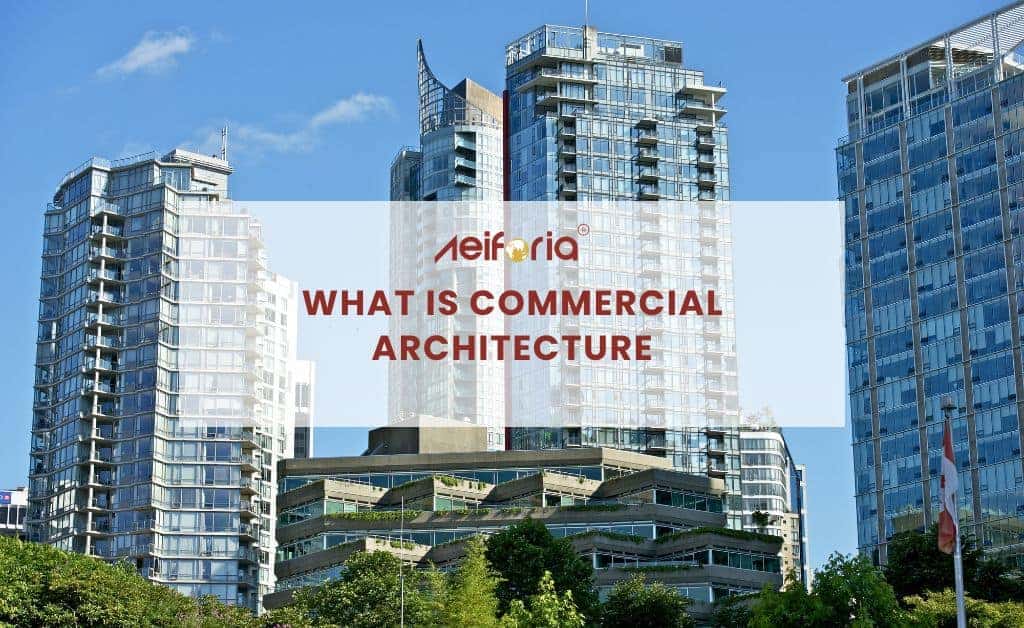
Commercial Architecture
Commercial architecture refers to designing, planning, and constructing buildings for commercial use, including office spaces, retail stores, restaurants, hotels, and other business establishments. This field of architecture focuses on creating functional and aesthetically pleasing buildings that are optimized for the needs of businesses and their customers. This article will explore commercial architecture, its benefits, unique features, and the people who need its services.
What is Commercial Architecture?
Commercial architecture refers to the specialized practice of designing and constructing buildings for commercial purposes. This type differs from residential architecture, which focuses on developing homes and other private residences. Commercial architecture also differs from different types of architecture, such as industrial architecture, which focuses on designing buildings for manufacturing and production facilities, and institutional architecture, which involves designing buildings for educational and government institutions.
The scope of commercial architecture is broad and includes various structures, including office buildings, retail stores, shopping malls, hotels, restaurants, and entertainment venues. Commercial architects work with clients to design functional, visually appealing, and optimized spaces for business operations.
How is Commercial Architecture Different from Other Types of Architecture?
While commercial architecture shares many similarities with other types of architecture, there are some key differences:
Functionality
One of the primary considerations in commercial architecture is functionality. Unlike residential buildings, designed primarily to provide a comfortable living space for individuals and families, commercial buildings are intended to serve a specific purpose. This purpose could be anything from providing office space for a business to housing a restaurant or retail store.
Because commercial buildings are intended to serve a specific function, the design and layout of these buildings must be optimized for that purpose. This often involves extensive planning and consultation with the client to determine their specific needs and requirements. Architects must consider factors such as traffic flow, accessibility, and the particular activities that will take place in the building when designing the layout and features of the space.
Attention to Branding
Another key difference between commercial and other types of architecture is the importance of branding. Commercial buildings are often designed to reflect the values and aesthetics of the business or organization that will occupy them. This could involve incorporating the company's logo and color scheme into the design of the building or using materials and textures that reflect the company's branding.
In addition to reflecting the company or organization's brand, commercial architecture must also be designed with the customer's or client's needs in mind. The building should be inviting and visually appealing, creating a positive impression and reinforcing the company's brand identity.
Consideration of Building Codes and Regulations
Commercial architecture is also subject to a wide range of building codes and regulations that do not apply to other types of architecture. These regulations are intended to ensure the safety and accessibility of the building for its occupants and visitors. They cover everything from the materials used in building construction to the placement and design of features such as stairways, elevators, and emergency exits.
Compliance with building codes and regulations is essential in commercial architecture. Architects must have a detailed understanding of these regulations to design buildings that meet these requirements. Failure to comply with these regulations can result in costly fines, legal penalties, and potential harm to the occupants of the building.
Integration of Technology
Finally, commercial architecture must also consider the latest technological advances. This could involve incorporating features such as smart lighting, HVAC systems, and security systems into the design of the building. Technology can also be used to enhance the functionality and accessibility of the building, such as by incorporating digital signage or touch screens for visitors.
Incorporating technology into commercial architecture can be a complex process, requiring extensive planning and consultation with experts in various fields. However, the benefits of doing so can be significant, including improved energy efficiency, enhanced security, and greater convenience for building occupants and visitors.
Who Needs Commercial Architecture Services?
Commercial architecture services can benefit any business or organization requiring a physical space. This includes small businesses, large corporations, non-profit organizations, and government agencies.
Commercial architecture services are essential for businesses starting or looking to expand their operations. By working with a commercial architect, businesses can ensure that their space is designed to meet their unique needs and will help them achieve their goals.
The Benefits of Commercial Architecture
Commercial architecture has many benefits for businesses, including the following:
Aesthetics
Commercial architecture focuses on creating visually attractive buildings that make a lasting impression on customers. A stunning building design can help a business stand out from its competitors and build a strong brand image.
Functionality
Commercial architecture is designed with the specific needs of businesses in mind. The layout, size, and features of the building are optimized for the efficient operation of the company. This includes traffic flow, storage space, and customer comfort.
Cost-effectiveness
Commercial architects are trained to design cost-effective buildings to construct and operate. This means that they will take into account factors such as energy efficiency, materials cost, and maintenance needs to create a structure that is both affordable and functional.
Energy Efficiency
Commercial buildings can be designed to be energy-efficient, which can reduce operating costs and help businesses meet sustainability goals.
Flexibility
Commercial buildings can be designed to be flexible and adaptable, which can allow businesses to easily modify the space as their needs change.
The Process of Commercial Architecture
The process of commercial architecture involves several stages, including:
Programming and Planning
This stage involves understanding the client's needs, goals, and objectives for the project. The commercial architect will work with the client to develop a program that outlines the functional requirements of the building.
Schematic Design
In this stage, the commercial architect will create initial designs for the building based on the program developed in the previous step. These designs will include sketches and diagrams that show the layout and organization of the building.
Design Development
In this stage, the commercial architect will refine the design and develop more detailed drawings and plans. This will include building materials, mechanical and electrical systems, and structural engineering.
Construction Documentation
During this stage, the commercial architect will create detailed construction documents with the necessary information for contractors to build the building. This will include drawings, specifications, and schedules.
Construction Administration
The final stage of commercial architecture involves overseeing the construction process to ensure that the building is built according to the design and specifications. The commercial architect will work with contractors and other professionals to ensure the project is completed on time and within budget.
Conclusion
Commercial architecture is a specialized field that involves designing and constructing buildings for businesses and organizations. Commercial architects are responsible for creating functional, aesthetically pleasing buildings that meet the needs of their clients. Critical considerations in commercial architecture projects include building codes and regulations, site selection, energy efficiency, and flexibility. Sustainable practices and current trends in commercial architecture include energy-efficient lighting and HVAC systems, sustainable materials, green roofs and walls, open floor plans, biophilic design, and mixed-use buildings. Businesses and organizations that require commercial architecture services include retail businesses, office buildings, healthcare facilities, educational institutions, and the hospitality industry.
FAQs
What is the difference between commercial architecture and residential architecture?
Commercial architecture focuses on designing commercial buildings, such as offices, retail stores, and hotels. In contrast, residential architecture is focused on developing homes and other residential spaces.
How much does commercial architecture cost?
The cost of commercial architecture services can vary depending on the size and complexity of the project, as well as the experience and qualifications of the commercial architect.
Can commercial architecture help me save money on energy costs?
Yes, by designing a space that is energy-efficient and sustainable, businesses can reduce their energy costs over time.
How long does it take to complete a commercial architecture project?
The timeline for a commercial architecture project can vary depending on the size and complexity of the project, as well as other factors such as permits and approvals. It is essential to work closely with your commercial architect to develop a realistic timeline for your project.
How do I choose a commercial architect?
When choosing a commercial architect, looking for someone with experience in designing spaces similar to yours and someone willing to work closely with you to meet your unique needs and goals is crucial.
Aeiforia Architects is well-known for creating commercial spaces that are both functional and visually stunning. Their highly skilled architects, designers, and project managers are committed to delivering exceptional results, whether you're looking to build a new commercial space or renovate an existing one. Please get in touch with them directly to learn more about their services and how they can help you bring your commercial architecture vision to life.






